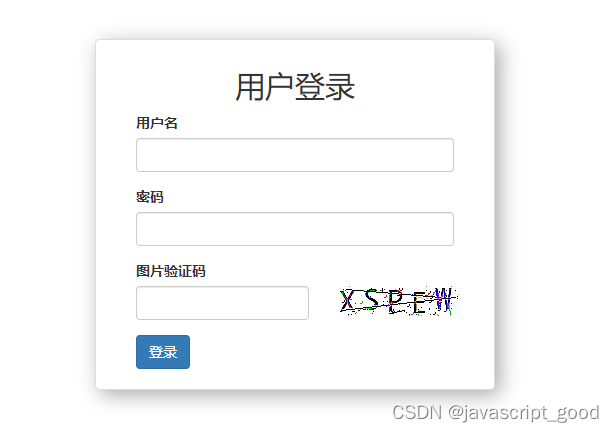一、用pillpw生成图片验证码
1、安装pillow
pip install pip install pillow
2、下载字体
比如:Monaco.ttf
3、实现生成验证码的方法
该方法返回一个img ,可以把这个img图片保存到内存中,也可以以文件形式保存到磁盘,还返回了验证码的文字。
在app01->utils->code.py, code.py内容如下:
import random
from PIL import Image,ImageDraw,ImageFont,ImageFilter
def check_code(width=120, height=30, char_length=5, font_file='Monaco.ttf', font_size=28):code = []img = Image.new(mode='RGB', size=(width, height), color=(255, 255, 255))draw = ImageDraw.Draw(img, mode='RGB')def rndChar():"""生成随机字母:return:"""return chr(random.randint(65, 90))def rndColor():"""生成随机颜色:return:"""return (random.randint(0, 255), random.randint(10, 255), random.randint(64, 255))# 写文字font = ImageFont.truetype(font_file, font_size)for i in range(char_length):char = rndChar()code.append(char)h = random.randint(0, 4)draw.text([i * width / char_length, h], char, font=font, fill=rndColor())# 写干扰点for i in range(40):draw.point([random.randint(0, width), random.randint(0, height)], fill=rndColor())# 写干扰圆圈for i in range(40):draw.point([random.randint(0, width), random.randint(0, height)], fill=rndColor())x = random.randint(0, width)y = random.randint(0, height)draw.arc((x, y, x + 4, y + 4), 0, 90, fill=rndColor())# 画干扰线for i in range(5):x1 = random.randint(0, width)y1 = random.randint(0, height)x2 = random.randint(0, width)y2 = random.randint(0, height)draw.line((x1, y1, x2, y2), fill=rndColor())img = img.filter(ImageFilter.EDGE_ENHANCE_MORE)return img, ''.join(code)
验证码的效果如下:

二、在登录界面加上验证码
1、添加一个验证码的url, 在urls.py 中增加:
from django.urls import path
from app01.views import user,depart,pretty,admin,accounturlpatterns = [path('login/account/',account.login),path('logout/',account.logout),path('image/code/',account.image_code),
]
2、在视图函数中增加验证码的处理
把生成后的图片保存再内存中,返回给页面,验证码的文字要先保存到session中,方便后面根用户输入的验证码进行校验。
from django.shortcuts import render,redirect,HttpResponse
from django import forms
from io import BytesIO
from app01.utils.code import check_code
def image_code(request):#调用pillow模块生成验证码img,code_string = check_code()#将验证码写入到自己的session中,一遍后续获取验证码进行校验request.session['image_code'] = code_string#给session设置60秒超时request.session.set_expiry(60)#将图片内容写入到内存中,from io import BytesIOstream = BytesIO()img.save(stream, 'png')return HttpResponse(stream.getvalue())
3、在登录页面增加验证码的输入框
{% load static %}
<!DOCTYPE html>
<html lang="en">
<head><meta charset="UTF-8"><title>Title</title><link rel="stylesheet" href="{% static 'plugins/bootstrap-3.4.1/css/bootstrap.min.css' %}"><style>.account {width: 400px;border-radius: 5px;border: 1px solid #dddddd;box-shadow: 5px 5px 20px #aaa;margin-left: auto;margin-right: auto;margin-top: 100px;padding: 20px 40px;}.account h2 {margin-top: 10px;text-align: center;}</style>
</head>
<body>
<div class="account"><h2>用户登录</h2><form method="post" novalidate>{% csrf_token %}<div class="form-group"><label >{{ form.username.label }}</label>{{ form.username}}<span style="color:red">{{ form.username.errors.0 }}</span></div><div class="form-group"><label >{{ form.passwd.label }}</label>{{ form.passwd }}<span style="color:red">{{ form.passwd.errors.0 }}</span></div><div class="form-group"><label for="id_code">图片验证码</label><div class="row"><div class="col-xs-7">{{ form.code }}<span style="color: red">{{ form.code.errors.0 }}</span></div><div class="col-xs-5"><img id="image_code" src="/image/code/"></div></div></div><button type="submit" class="btn btn-primary">登录</button></form></div><script src="{% static 'js/jquery-3.7.0.min.js' %}"></script>
<script src="{% static 'plugins/bootstrap-3.4.1/js/bootstrap.min.js' %}"></script>
</body>
</html>
登录界面效果如下:

3、登录的时候对验证码进行校验
获取到用户输入的验证码的值,再从session中取出之前保存的验证码的值,两者比较,如果一致就登录,不一致就重定向到登录界面,提示验证码错误。
还要注意的是,session在生成验证码的时间设置了过期时间是60s, 在登录的时候需要重写设置session的有效期。
在登录的视图函数修改如下:
def login(request):"""用户登录"""if request.method == 'GET':form = LoginForm()return render(request,'login.html',{'form':form})form = LoginForm(data=request.POST)if form.is_valid():#验证码的校验# 这里为什么用pop 是因为cleaned_data获取到的是用户输入的所有信息,包括验证码,但是后面用户名密码根数据库校验的时候验证码是不在数据库的,所以这里就把验证码给去掉user_input_code = form.cleaned_data.pop('code')code = request.session.get('image_code',"")if code.upper() != user_input_code.upper():form.add_error("code","验证码错误")return render(request,'login.html',{'form':form})#print(form.cleaned_data) #获取到的值是一个字典{'username': 'root', 'passwd': '4233c0d596c55f18df8c99ad1ad8af4f'}#校验数据库的用户名和密码admin_object = models.Admin.objects.filter(**form.cleaned_data).first()if not admin_object:form.add_error('passwd','用户名或密码错误')return render(request,'login.html',{'form':form})#用户名和密码正确#网站生成随机字符串; 写到用户浏览器的cookie中,再写入到session中request.session['info'] = {'id':admin_object.id,'name':admin_object.username}#重新设置session 的有效期,为24小时request.session.set_expiry(60*60*24)return redirect('/admin/list/')return render(request,'login.html',{'form':form})
![[前端系列第1弹]HTML入门教程:从零开始学习Web页面的基础知识](http://pic.xiahunao.cn/[前端系列第1弹]HTML入门教程:从零开始学习Web页面的基础知识)
)







)






)
动态规划解题套路框架)
